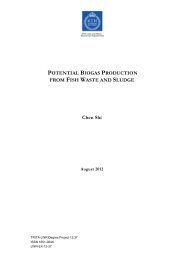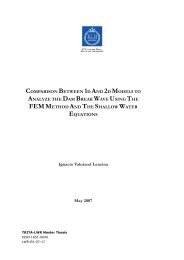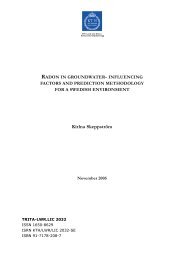Water <strong>sources</strong>, <strong>infrastructure</strong>, <strong>space</strong> <strong>and</strong> <strong>the</strong> <strong>dynamics</strong> <strong>of</strong> environmental diseases in Saboba District: Using GISCHAPTER 1IntroductionFrom <strong>the</strong> beginning <strong>of</strong> <strong>the</strong> 21st century, most countries are faced withdevelopmental challenges <strong>of</strong> how to manage <strong>the</strong>ir <strong>water</strong> re<strong>sources</strong> toensure sustainable use <strong>and</strong> reduce its health consequences. This problemis estimated to be more prevalent in developing countries. For example,<strong>the</strong> International Water Management Institute (IWMI, 2000) haveestimated that by 2025, <strong>water</strong> shortages will be more prevalent amongpoorer countries, <strong>and</strong> that Sub-Saharan Africa (SSA) will face <strong>water</strong>supply shortages due to economic constraints to develop safe drinking<strong>water</strong>, as well as excessive population growth. This may deny <strong>the</strong>secountries from achieving <strong>the</strong> target <strong>of</strong> <strong>the</strong> Millennium DevelopmentGoals (MDGs) on <strong>water</strong> availability <strong>and</strong> quality. World HealthOrganisation <strong>and</strong> United Nations Children's Fund, WHO <strong>and</strong> UNICEF,(2004) have also stated that more than one billion people on earthcurrently rely on <strong>water</strong> <strong>sources</strong> that are unsafe, unreliable, or difficult toaccess for <strong>the</strong>ir daily domestic use. As a result, millions <strong>of</strong> people, most<strong>of</strong> <strong>the</strong>m children, women <strong>and</strong> <strong>the</strong> aged are dying annually from diseasesrelated to poor <strong>water</strong> quality. Vörösmarty et al (2000) believe <strong>the</strong>magnitude <strong>of</strong> this challenge could double in <strong>the</strong> next two decades. WhileWHO (2004) stated that diarrhoeal diseases are responsible for 1.8million annual death, it also estimated that 88% <strong>of</strong> that burden isattributable to unsafe <strong>water</strong> supply <strong>and</strong> sanitation – largely in developingcountries, where Ghana is not an exception. WHO (2004) noted that; “asignificant amount <strong>of</strong> <strong>the</strong>se diseases could be prevented… throughbetter access to safe <strong>water</strong> supply, adequate sanitation facilities <strong>and</strong> betterhygienic practices”.Ghana is no exemption from this estimated health burden, due in part to<strong>the</strong> depletion in quality <strong>of</strong> its <strong>water</strong> re<strong>sources</strong>. Such depletion <strong>of</strong> <strong>water</strong>quality has become key problem facing Ghana, making herdevelopmental objectives ever more daunting, as it places healthconsequences on <strong>the</strong> people <strong>and</strong> reduce <strong>the</strong>ir productivity. Recognisingthis need to reduce <strong>water</strong>-related health problems by protecting <strong>water</strong>re<strong>sources</strong>, <strong>the</strong> revised population policy <strong>of</strong> Ghana (Ghana, 1994) statesthat “Government’s new policies are to tackle <strong>the</strong> growing problems <strong>of</strong>… river pollution <strong>and</strong> toxic waste, through specific interventionmeasures including education <strong>and</strong> awareness programmes...” (p. 7). Aspart <strong>of</strong> efforts to help avert this problem, government has m<strong>and</strong>ated <strong>the</strong>Water Re<strong>sources</strong> Commission (WRC) to develop a Buffer Zone Policyto protect riverbanks <strong>and</strong> o<strong>the</strong>r <strong>water</strong> <strong>sources</strong>Most <strong>of</strong> <strong>the</strong>se health problems occur in poorer areas such as SabobaDistrict <strong>of</strong> Nor<strong>the</strong>rn Ghana. The health impacts <strong>and</strong> problems stretchout fur<strong>the</strong>r <strong>and</strong> fur<strong>the</strong>r in both <strong>space</strong> <strong>and</strong> time. Despite <strong>the</strong> recognition<strong>of</strong> <strong>the</strong> relation between <strong>water</strong> need <strong>and</strong> health related problems, itsintegration are yet to be clearly systematised <strong>and</strong> understood in Ghana,<strong>and</strong> many o<strong>the</strong>r developing countries. Spatial aspect on micro level <strong>of</strong>this health problem is not also identified, at least not in Saboba district.In order to allow informed decision-making on interventions aimed atprevention <strong>and</strong> control <strong>of</strong> environmental diseases, <strong>and</strong> specifically,<strong>water</strong>-related diseases, it is crucial to carry out research into its spatial<strong>dynamics</strong> <strong>and</strong> causes in each specific region.1
Mat<strong>the</strong>w Biniyam KursahTRITA LWR Master ThesisProblem StatementSustainable development which emerged with a built-in intergenerationalequity defined to include <strong>the</strong> interest <strong>of</strong> future generations, gained fameafter <strong>the</strong> publication <strong>of</strong> Brundtl<strong>and</strong> Report, WCED (1987). Thesustainable use <strong>of</strong> re<strong>sources</strong>, now popularised, underlies <strong>the</strong> perception<strong>of</strong> <strong>the</strong> use <strong>of</strong> natural re<strong>sources</strong> such as <strong>water</strong> in <strong>the</strong> Ghanaian culture. Asput forward by a popular Ghanaian chief, natural re<strong>sources</strong> such as <strong>water</strong>belongs to a countless number <strong>of</strong> people, many <strong>of</strong> whom are dead, <strong>the</strong> living <strong>and</strong> thoseyet unborn (Nana Ofori Atta II, 1912-1942). It is also widely known thatavailability <strong>of</strong> good quality <strong>water</strong> <strong>and</strong> its quantity on one h<strong>and</strong> <strong>and</strong> betterhealth <strong>of</strong> people on <strong>the</strong> o<strong>the</strong>r are intrinsically linked (WHO, 2004).Generally, Saboba district has enough <strong>water</strong> needed by its population.The district is not part <strong>of</strong> areas in Ghana considered as <strong>water</strong> stressed tocause many health problems. However, while working with IntegratedDevelopment Centre (IDC), a local Non-Governmental Organisation(NGO), implementing <strong>the</strong> newly established Community HealthInsurance Scheme, it was discovered that about 70% <strong>of</strong> <strong>the</strong> diseasesreported at <strong>the</strong> hospitals <strong>and</strong> brought to <strong>the</strong> NGO outfit were <strong>water</strong>relateddiseases such as Malaria, Typhoid <strong>and</strong> diarrhoeal. The proportionwas even greater when <strong>the</strong> health burdens were classified asenvironmental diseases to include respiratory infections. Also, in all casesfrom 2002 to 2005, <strong>the</strong>re have been astronomical increases in <strong>the</strong> rates<strong>of</strong> disease prevalence; with 57.5% for Malaria, diarrhoeal diseases(58.6%), <strong>and</strong> Typhoid rising by 4698% (District Health ManagementTeam, DHMT, 2006). If Nana Ofori Atta II <strong>and</strong> <strong>the</strong> Ghanaian concepttowards natural re<strong>sources</strong> (stated above) is indeed in practice, <strong>the</strong>n onewill think that <strong>the</strong> <strong>water</strong> re<strong>sources</strong> will be carefully protected <strong>and</strong>managed well for <strong>the</strong> present <strong>and</strong> <strong>the</strong> future generations yet unborn. Thespatial dimension to <strong>the</strong>se diseases has not yet being given muchattention. What is conspicuously unclear is whe<strong>the</strong>r <strong>the</strong>se diseases haveany relation with proximity to <strong>water</strong>courses, district capital (main town),roads, <strong>the</strong> type <strong>of</strong> l<strong>and</strong> cover <strong>and</strong> elevation? If <strong>the</strong>se environmentaldiseases have relation to <strong>water</strong>courses, <strong>the</strong>n ano<strong>the</strong>r puzzle <strong>the</strong>reforearises – what is happening to <strong>the</strong> <strong>water</strong> re<strong>sources</strong> in <strong>the</strong> district that iscausing <strong>the</strong>se health complications even though <strong>the</strong> government hasprovided pipe-borne <strong>water</strong> in <strong>the</strong> district. This study <strong>the</strong>refore seeks tounravel <strong>the</strong>se puzzles.Research QuestionsThis study seeks to provide explanatory answers to <strong>the</strong> followingquestions;1 Whe<strong>the</strong>r <strong>the</strong>re are legal frameworks for protecting <strong>water</strong> re<strong>sources</strong> in <strong>the</strong>Saboba district?2 Is <strong>the</strong>re a spatial relation between environmental diseases <strong>and</strong> distancesto <strong>the</strong> main town, roads, <strong>water</strong>courses, <strong>the</strong> type <strong>of</strong> l<strong>and</strong> cover <strong>and</strong>elevation (also referred as spatial variables)?3 What is causing <strong>the</strong> higher rates <strong>of</strong> <strong>water</strong>-related diseases in <strong>the</strong> district?Goal <strong>and</strong> objectivesThe goal <strong>of</strong> this study is to look into <strong>the</strong> spatial <strong>dynamics</strong> <strong>and</strong> causes <strong>of</strong>high rates <strong>of</strong> environmental diseases, with special reference to <strong>water</strong>relateddiseases, in Saboba District.The Specific Objectives are to;Identify traditional <strong>and</strong> modern methods <strong>of</strong> protecting <strong>water</strong>re<strong>sources</strong> in Saboba district.2
- Page 1 and 2: Supervisor: Ulla MortbergCo-supervi
- Page 3 and 4: Water sources, infrastructure, spac
- Page 5 and 6: Water sources, infrastructure, spac
- Page 7 and 8: Water sources, infrastructure, spac
- Page 9 and 10: Water sources, infrastructure, spac
- Page 11 and 12: Water sources, infrastructure, spac
- Page 13 and 14: Water sources, infrastructure, spac
- Page 15: Water sources, infrastructure, spac
- Page 19 and 20: Matthew Biniyam KursahTRITA LWR Mas
- Page 21 and 22: Matthew Biniyam KursahTRITA LWR Mas
- Page 23 and 24: Matthew Biniyam KursahTRITA LWR Mas
- Page 25 and 26: OberadeYusungaManieBilyimbaMatthew
- Page 27 and 28: Matthew Biniyam KursahTRITA LWR Mas
- Page 29 and 30: Matthew Biniyam KursahTRITA LWR Mas
- Page 31 and 32: Matthew Biniyam KursahTRITA LWR Mas
- Page 33 and 34: Matthew Biniyam KursahTRITA LWR Mas
- Page 35 and 36: Matthew Biniyam KursahTRITA LWR Mas
- Page 37 and 38: Matthew Biniyam KursahTRITA LWR Mas
- Page 39 and 40: Matthew Biniyam KursahTRITA LWR Mas
- Page 41 and 42: PercentagePercentageMatthew Biniyam
- Page 43 and 44: Matthew Biniyam KursahTRITA LWR Mas
- Page 45 and 46: Matthew Biniyam KursahTRITA LWR Mas
- Page 47 and 48: Matthew Biniyam KursahTRITA LWR Mas
- Page 49 and 50: BilyimbaMatthew Biniyam Kursah Nadu
- Page 51 and 52: ManieBilyimbaBaguliMatthew Biniyam
- Page 53: ManieBilyimbaMatthew Biniyam Kursah
- Page 56 and 57: Matthew Biniyam KursahTRITA LWR Mas
- Page 58 and 59: Matthew Biniyam KursahTRITA LWR Mas
- Page 60 and 61: Matthew Biniyam KursahTRITA LWR Mas
- Page 62 and 63: Matthew Biniyam KursahTRITA LWR Mas
- Page 64 and 65: Matthew Biniyam KursahTRITA LWR Mas
- Page 66 and 67:
PercentagesPercentagesMatthew Biniy
- Page 68 and 69:
PercentagesMatthew Biniyam KursahTR
- Page 70 and 71:
Matthew Biniyam KursahTRITA LWR Mas
- Page 72 and 73:
Matthew Biniyam KursahTRITA LWR Mas
- Page 74 and 75:
Matthew Biniyam KursahTRITA LWR Mas
- Page 76 and 77:
Matthew Biniyam KursahTRITA LWR Mas
- Page 78 and 79:
Matthew Biniyam KursahTRITA LWR Mas
- Page 80 and 81:
Matthew Biniyam KursahTRITA LWR Mas
- Page 82 and 83:
Matthew Biniyam KursahTRITA LWR Mas
- Page 84 and 85:
Matthew Biniyam KursahTRITA LWR Mas
- Page 86 and 87:
Matthew Biniyam KursahTRITA LWR Mas
- Page 88 and 89:
Matthew Biniyam KursahTRITA LWR Mas
















